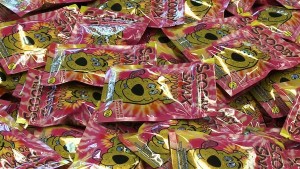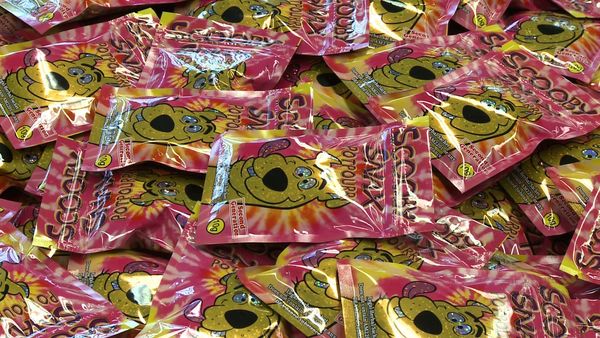 William Wells, a homeless man living in New York City, first started using K2 about a year ago. “My brain is connected to the chemicals,” he said. “It will have you running down the block. It will have you fighting yourself. It will have you getting very violent. It will have you living like a bum. . . . I wish I could stop, but I can’t stop. I can’t stop.” An East Harlem resident said that K2 was being sold 24 hours a day in the area. “Every day I see people doing it right there on the street. It makes them stuck. They stand in one place for hours at a time.” Read more from the original article by Matthew Speiser here.
William Wells, a homeless man living in New York City, first started using K2 about a year ago. “My brain is connected to the chemicals,” he said. “It will have you running down the block. It will have you fighting yourself. It will have you getting very violent. It will have you living like a bum. . . . I wish I could stop, but I can’t stop. I can’t stop.” An East Harlem resident said that K2 was being sold 24 hours a day in the area. “Every day I see people doing it right there on the street. It makes them stuck. They stand in one place for hours at a time.” Read more from the original article by Matthew Speiser here.
New York City Mayor Bill de Blasio signed legislation recently that banned the sale of synthetic cannabinoids, commonly known as K2 or spice. The law also bans the sale of synthetic stimulants known as bath salts. Not only are there possible civil and criminal penalties, the legislation authorizes the city to close down businesses that violate the law twice in a three-year period. The New York Times reported in September 2015 that the proposed ban would include selling any drug marketed as synthetic marijuana and any imitations with effects similar to the synthetic cannabinoids.
Authorities did begin to crack down on the sale and distribution of these new psychoactive substances (NPS). Ten defendants were charged and 90 bodegas (convenience stores) were raided. These included six retail outlets on 125th Street in Harlem, which has become ground zero for K2 use among the homeless in the City. Nicholas Casey wrote how:
Crowds of up to 80 or 100 homeless people come in on buses from a nearby shelter on Randalls Island, drawn by heroin recovery clinics nearby, and spend the day there under the influence of this cheaper narcotic. The block between Park and Lexington Avenues appears at times to be a street of zombies.
Police raids on 125th Street in July of 2015 led to confiscations of more than 8,000 packets of K2. But many of the stores continued selling the drug. The sheer number of users on the block has left police officers edgy. “It quickly can become a kind of group mentality where the officers, or even multiple officers, are outnumbered,” according to Tom Harnisch, commander of the 25th Precinct. NYPD Commissioner Bill Bratton described the drugs as “weaponized marijuana.” He said: “This is a scourge on our society, affecting the most disadvantaged neighborhoods and our most challenged citizens. It affects teenagers in public housing, homeless in the city shelter system, and it’s quite literally flooding our streets.”
The New York Daily News filmed a six-minute documentary,”K2 in New York City.” It opens with a 20 second shot of a guy catatonically zoned out on K2. A homeless man who sells K2 held up a packet of “Trippy,” saying: “I want Obama to see this too.” Another person said it was ten times worse than heroin. Against the background of two police officers standing by a person crying out on the sidewalk, a graphic noted that: “Between April 2015 and September 2015 there were more than 4,700 K2-related emergency room visits in NY state compared to just 230 during the same period in 2014.” Another man said that was how he got through the day, dealing with his misery and pain by doing the drug.
A woman said: “Don’t do it. If people haven’t done it … if I know for a fact that you haven’t smoked it, I will not let you smoke it. I wouldn’t ruin somebody’s life like that.” NYC paramedic Robert Kelly said it seems to be effecting mentally ill homeless people in the shelter systems; people that are known drug users. “Unfortunately it’s cheap; it’s easy to get.” US Attorney Preet Bharara announced an operation that seized over 200 kilograms of chemicals and an estimated 275,000 packets of finished product that would have totaled more than 2,700 kilograms of spice. A conservative estimate of the street value of that amount of spice is over $30 million dollars.
The Fix described this joint DEA and NYPD operation as targeting the sale of the drugs in all five NYC boroughs. Part of the operation raided five processing facilities and warehouses used to store and distribute the drugs. More than 80 bodegas were searched as part of the overall operation. DEA Special Agent in Charge, James Hunt said: “Synthetic cannabinoids are anything but safe. They are a toxic cocktail of lethal chemicals. . . . By investigating and arresting manufacturers and distributors of ‘spice’ in the city, we have cut off the accessibility for those feeding the beast.”
The NYC Department of Health and Mental Hygiene has an information page on K2 that describes some of the risks associated with K2 use. “Information for Consumers” said the most common adverse effects of K2 reported include: lethargy, confusion, drowsiness, respiratory depression, nausea, vomiting, tachycardia (increased heart rate), paranoid behavior, agitation, irritability, headache seizures, and loss of consciousness. Severe side effects could include acute renal failure and cardiovascular and central nervous system complications. “In rare instances, use of cannabinoids has been linked to death.”
John Lavitt opened his article for The Fix with a comment on how synthetic drug sales have allegedly fueled terrorism, a claim which has some clear evidence for it. One of the name brands of synthetic marijuana named in The New York Daily News video described above, Scooby Snax, was involved in a DEA raid on a Birmingham Alabama warehouse in May of 2013. Sales from the product were linked to $40 million in wire transfers to Yemen. See “Strange Bedfellows: Terrorists and Drugs.” Also see “The Double-Edged Sword of Narco-Terrorism.”





